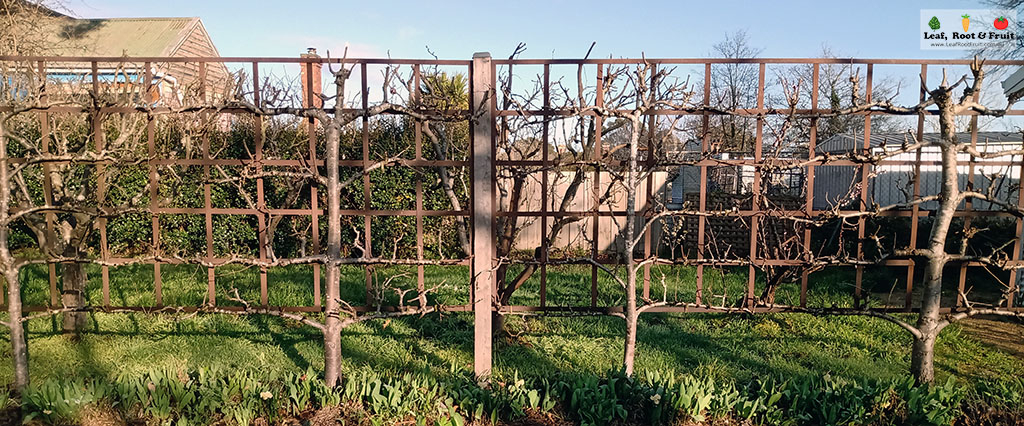
What is an Espalier?
“Espalier” refers to special practices for training fruiting trees onto trellises. Espaliers save space and are beautiful works of art. There are many styles and designs of espalier that can be grown against a wall, a building or on an existing fence or wires. Espalier can also be used as a screen in the garden, to create rooms or to hide unsightly areas. Espaliers can use space along the drive that would be too small for a full tree. They provide interest in all seasons: stunning form in winter, flowers in spring, fruit in summer and autumn’s foliage.
Where to Plant Your Espalier
Most fruiting trees require a full sun position to be productive. Generally, north facing walls and fences are the best location. East and west facing walls can also be used.
If you have a wall or fence that is made of brick, iron or colourbond then you will need to position your espalier 30 to 40 cm away from it. This is to stop the tree from cooking on hot summer days. You may notice some photos on the internet of espaliers trained directly onto masonry walls. These are generally in Europe, where the sun is much less intense. In Victoria our summers are too hot to grow plants directly against most walls.
I recommend that your espalier framework is erected independently of your fence. Timber paling fences have a lifespan of less than 10 years. Your espalier will likely outlive the fence so having them trained on a separate structure means the fence can be replaced without damaging your tree.
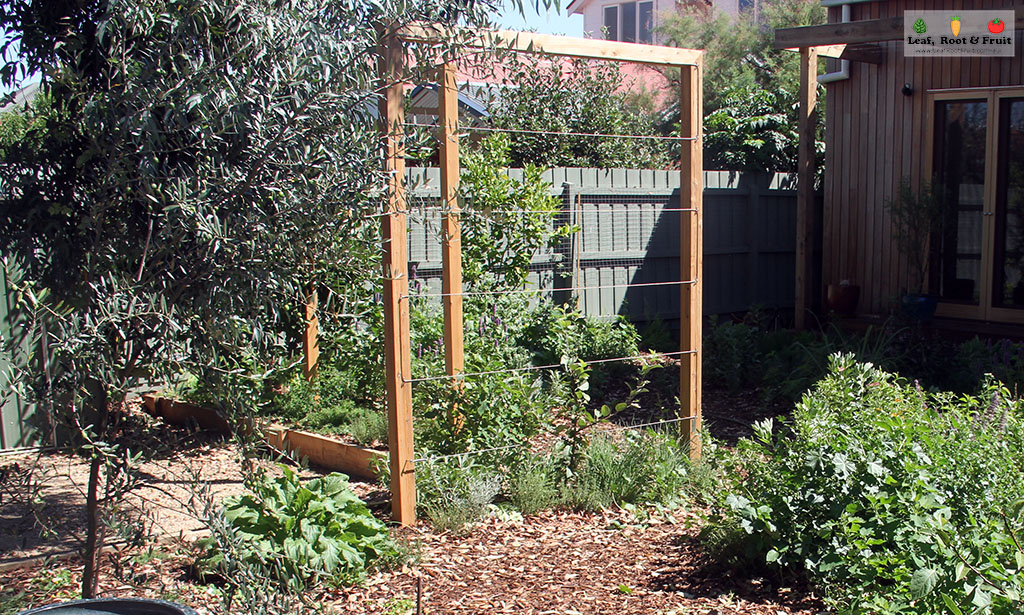
Of course, espaliers don’t need to go against a fence or wall at all. They can be planted anywhere and trained on separate trellis structures as a feature. Using them creatively can create rooms within the garden.
Trellis Options for Espaliers
Setting up a trellis framework is necessary to train your espaliers. There a lots of different materials choices. Keep in mind that a well-cared for espalier tree will last decades, if not centuries. So it is a good idea to invest in materials that will have longevity.
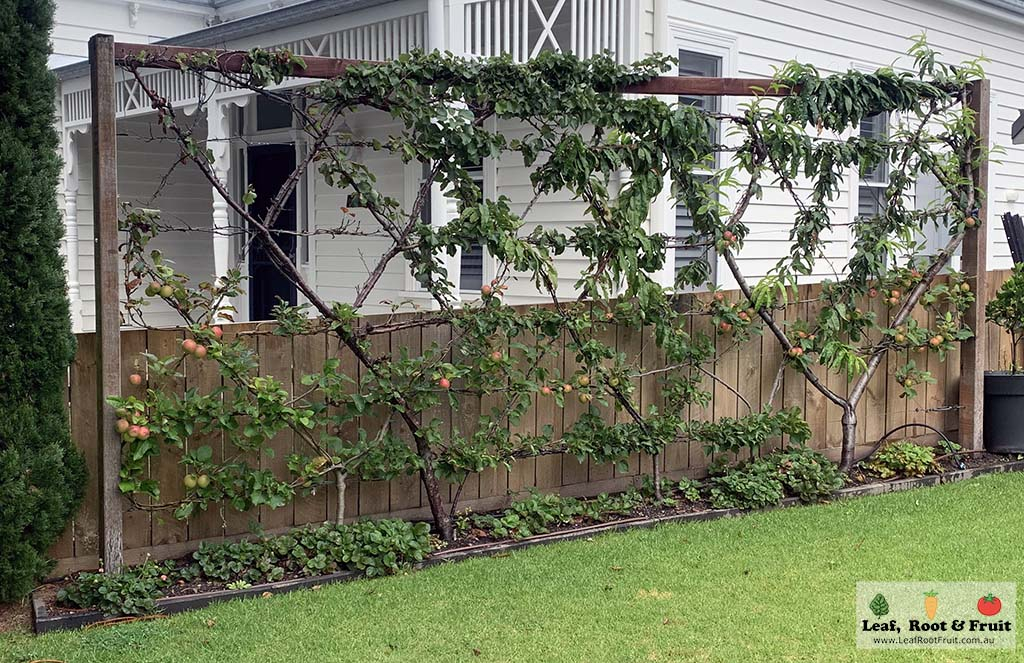
Once branches have been trained to their desired shape they will stay there, regardless of the framework. However, branches will need significant support during summer and autumn, when the branches are covered in fruit. it is possible to replace the framework structure every decade or so, if required. This would best be done in winter while the tree is dormant.
Potted Espaliers
Espaliers can be grown in pots. This can either be in the first few years before planting into the garden, or they can be kept permanently in pots. I’ve found bamboo canes to be the best solution for setting up a supporting framework for potted trees. Check out this guide for general information on growing fruit trees in pots.
In ground, Permanent Espaliers
These are best constructed with a timber or steel post framework. Timber post options include cypress (dressed or rough-sawn) and treated pine. These posts should be sunk quite deeply into the soil (600mm+) and concreted into place. Consider adding a cross brace at the top to stop the weight of the branches sagging wires etc and pulling the posts inwards.
Star Posts can also be used as a cheaper, alternative. However, I’ve found that they are more prone to sagging under the weight of the fruit.
Between the posts you can install:
- Stainless steel cabling (only suitable to horizontal cordons)
- Fencing Wire
- Galvanised or stainless steel mesh panels (which can support horizontal cordons and fan shaped espaliers)
Ultimately your decision needs to be based on a combination of budget, longevity and aesthetics.
Click on trellis images to enlarge
Rootstock Choices for Espaliered Fruit Trees
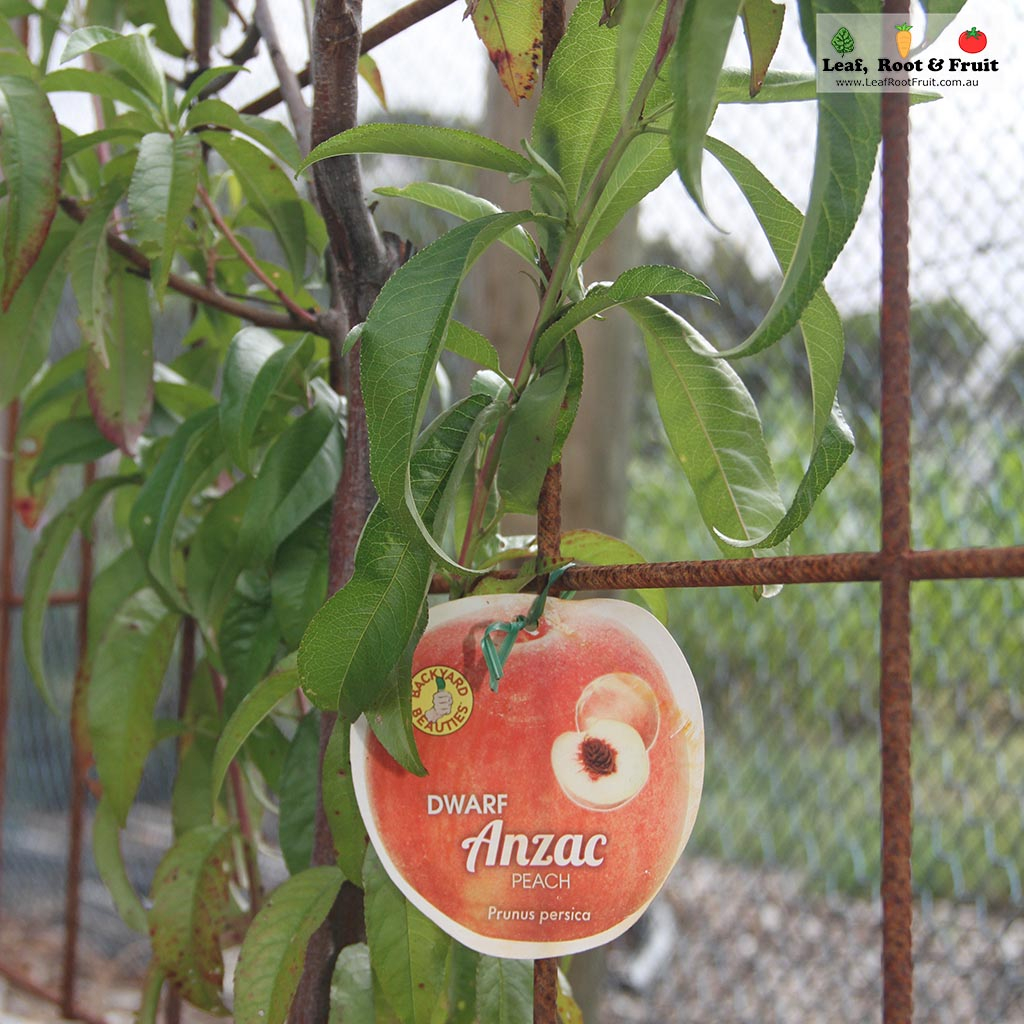
The development of dwarfing rootstocks, for many different fruit trees, means that we can now grow very productive trees in much smaller spaces. There are many different dwarf rootstocks and they all dwarf trees to various degrees. Fruit trees grafted onto dwarf rootstocks have many advantages over standard sized trees. See my dedicated page on fruit tree rootstocks for more information
Espalier trees (except for citrus) should generally be grafted onto dwarfing rootstocks. Failure to do so will see the tree quickly become overgrown and need a lot of maintenance.
Espalier Fruit Tree Shapes
There are many different espalier shapes that can be applied to fruit trees. I’ve described the most popular two shapes below. Most espaliers are set up using a framework or trellis structure to help train them into shape.
Horizontal Cordon
The most popular, and well known is the Horizontal-Cordon. As the name suggests this shape of tree is made of a central trunk with horizontal branches radiating out at specific intervals up the tree.
This shape of espalier is best suited to spur bearing fruit trees (Apples & Pears). Other types of fruiting trees are better shaped as a Fan Espalier.
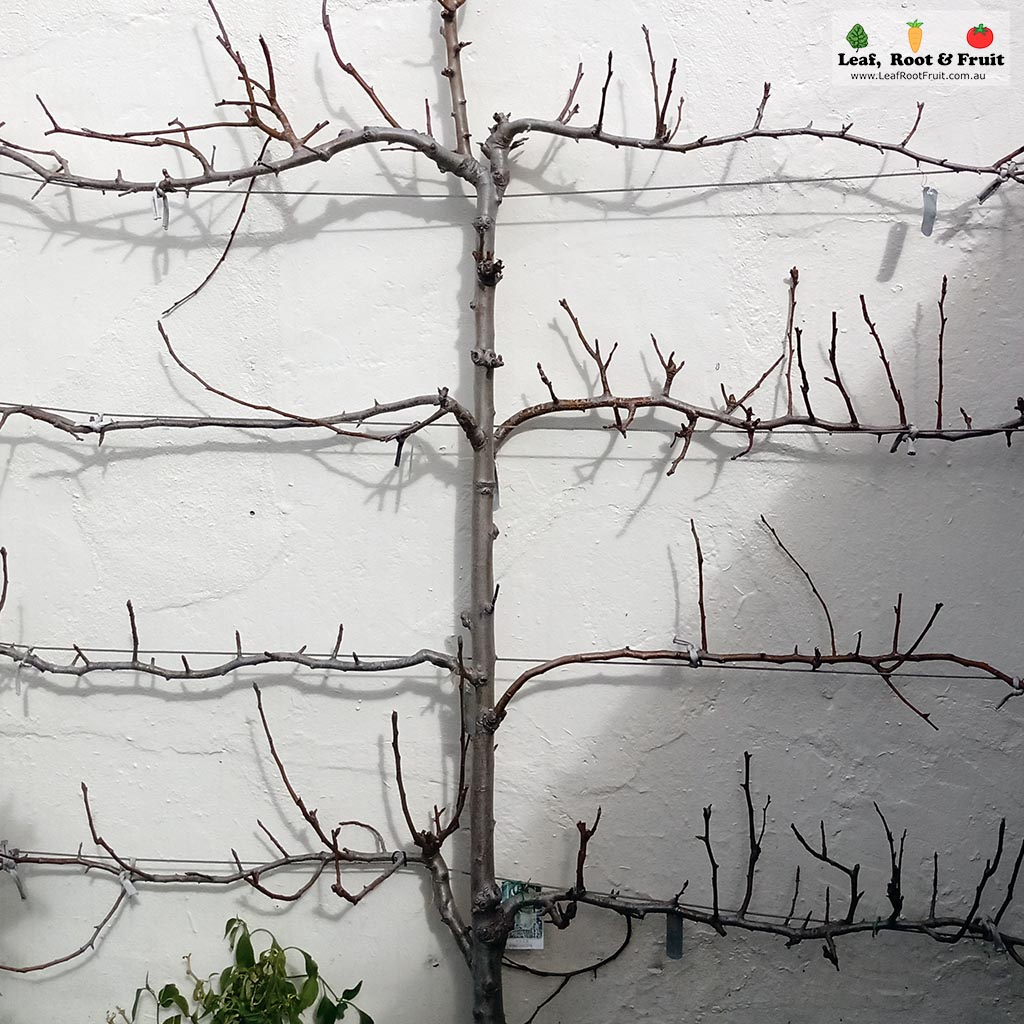
To set up a Horizontal cordon cut the main limb back to where you want the first branches to occur. This should stimulate growth of three or more new branches. As they grow, two can be trained horizontally. The third can be allowed to continue to grow vertically until it reaches the point where the next branching is to occur. Always leave the growing tips of the horizontal branches vertical. This allows them to continue vigorous growth. Prematurely forcing lateral branches into the horizontal position will slow growth and cause the tree to direct energy into the vertical branches and the top of the tree. Once this occurs it makes it very difficult to encourage growth into lower, horizontal branches.
Fan Shaped Espalier
Fan shapes are easier to manage and maintain that horizontal cordons. All fruiting trees can be pruned to a fan shape (as opposed to a horizontal cordon suited only to Apples and Pears). Personal preference will dictate whether you prune your trees into a formal fan (where each branch radiates to create a symmetrical, structured tree) or an informal fan (where branches are tied back into a 2-dimensional structure as and wherever they grow).
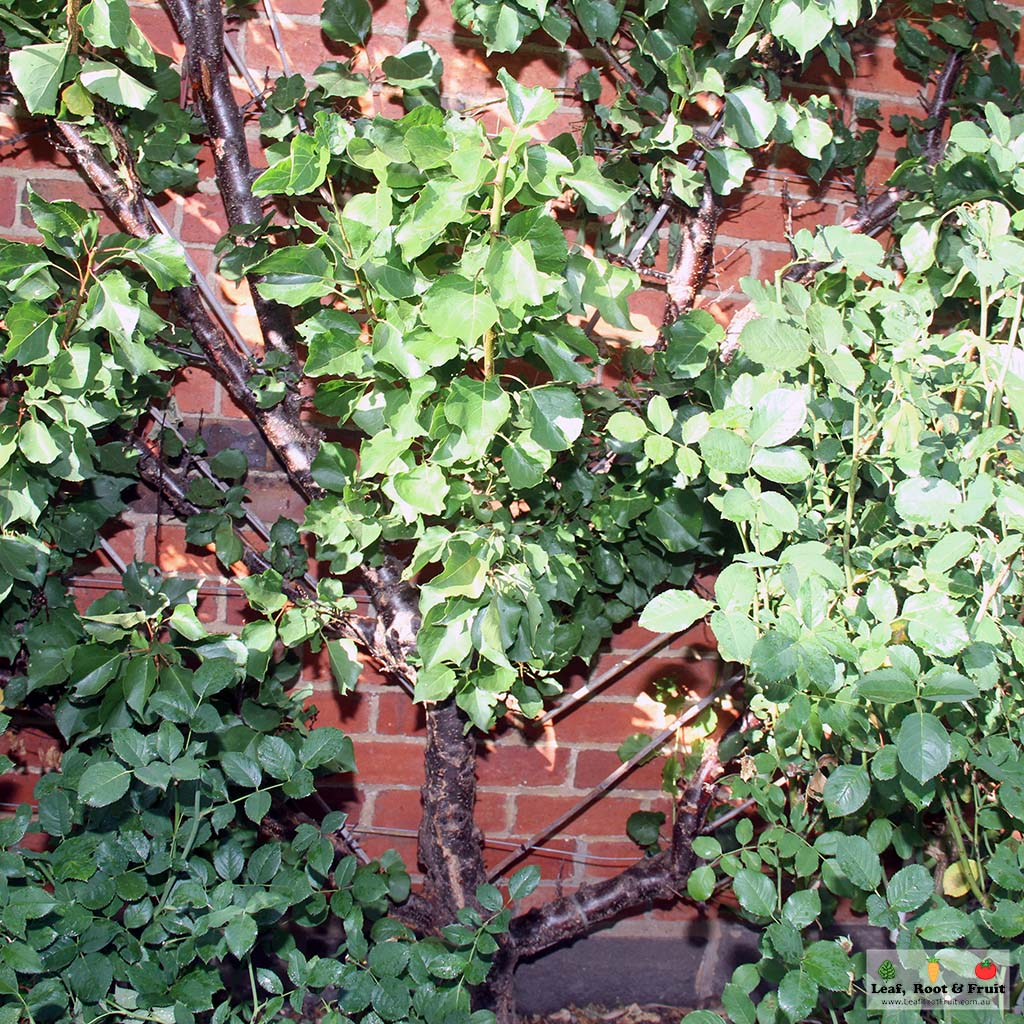
Tree Types for Espaliers
Spur bearers (apples and pears) are perfect for horizontal cordons. Training branches along a horizontal plane slows the sap flow and encourages spur formation.
Unlike peaches and nectarines, you can usually safely remove all of the current years’ growth without affecting yields too much. This makes them ideal for espaliers. Spur bearing trees are very forgiving when being pruned. Although, keep in mind that a few varieties of apples are in fact tip bearers (or a combination of both) and need to be managed differently.
Tip bearing fruit trees (Citrus, fig, olives, pomegranate) are best trained as an informal espalier or green wall.
Apricots, peaches, nectarines and Japanese plums fruit entirely on fresh growth and are best suited to growing in fan shapes.
Suitability to Espalier of Different Tree Types
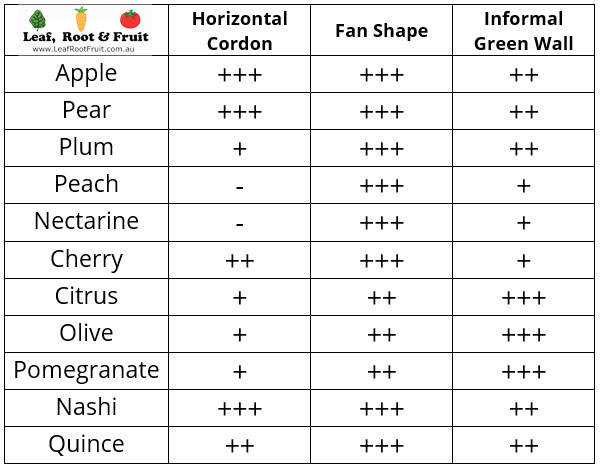
Training the Fruit Tree into an Espalier
Espalier trees will need pruning and training several times over each growing season. Gently bend the branches into the desired shape and tie into position.
Prune off any unwanted growth. When pruning spur bearers leave a 10cm stub to develop into fruiting spurs.
Focus on developing lateral growth first (ie grow the tree wide) rather than trying to develop height. It is easy to train a tree to be tall. However, once it has done so, it can be very difficult to encourage the lower branches to add extra growth. Lower branches may remain small and stunted if not encouraged to grow to their full length before developing the upper tiers.
I have put together a series of time lapse videos of espalier fruit tree pruning of some apples, pear and nashi trees. It may give you some ideas on how to go about it.
Ties
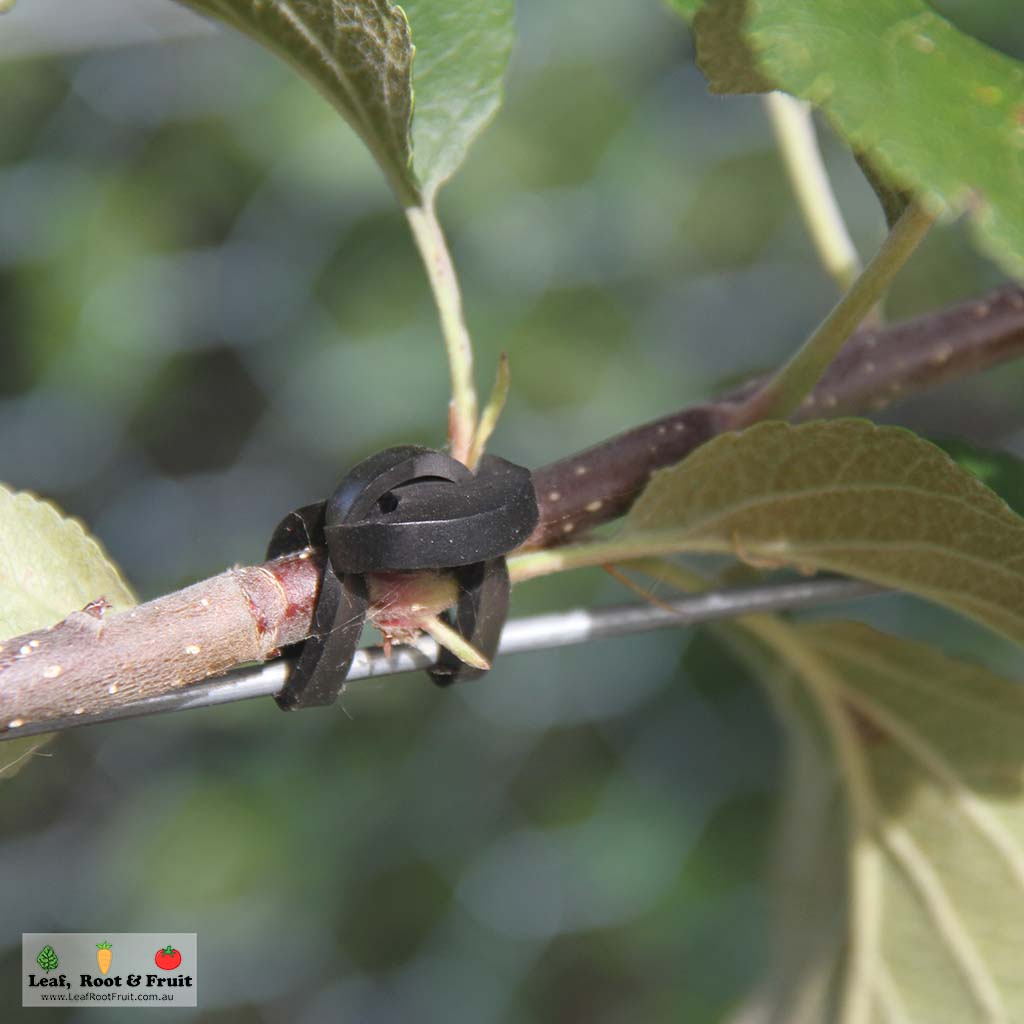
When training your espalier, you will need to have a method of tying the branches to the framework. Some options are:
- Horticultural ties
- Sisal String
- Old stockings
Avoid using nylon string or other materials that don’t stretch and break down. They may ring bark the branches and cause die back.
How to Encourage your Espalier to Develop New Branches
Pruning of fruit trees usually requires you to remove foliage from the plant. However, sometimes you may want to induce a tree to grow a branch in a particular place. This is especially important when training espalier trees. One option to induce a tree to send out lateral branches, is to make a header cut a few centimetres below where you want the next stage of the espalier to branch.
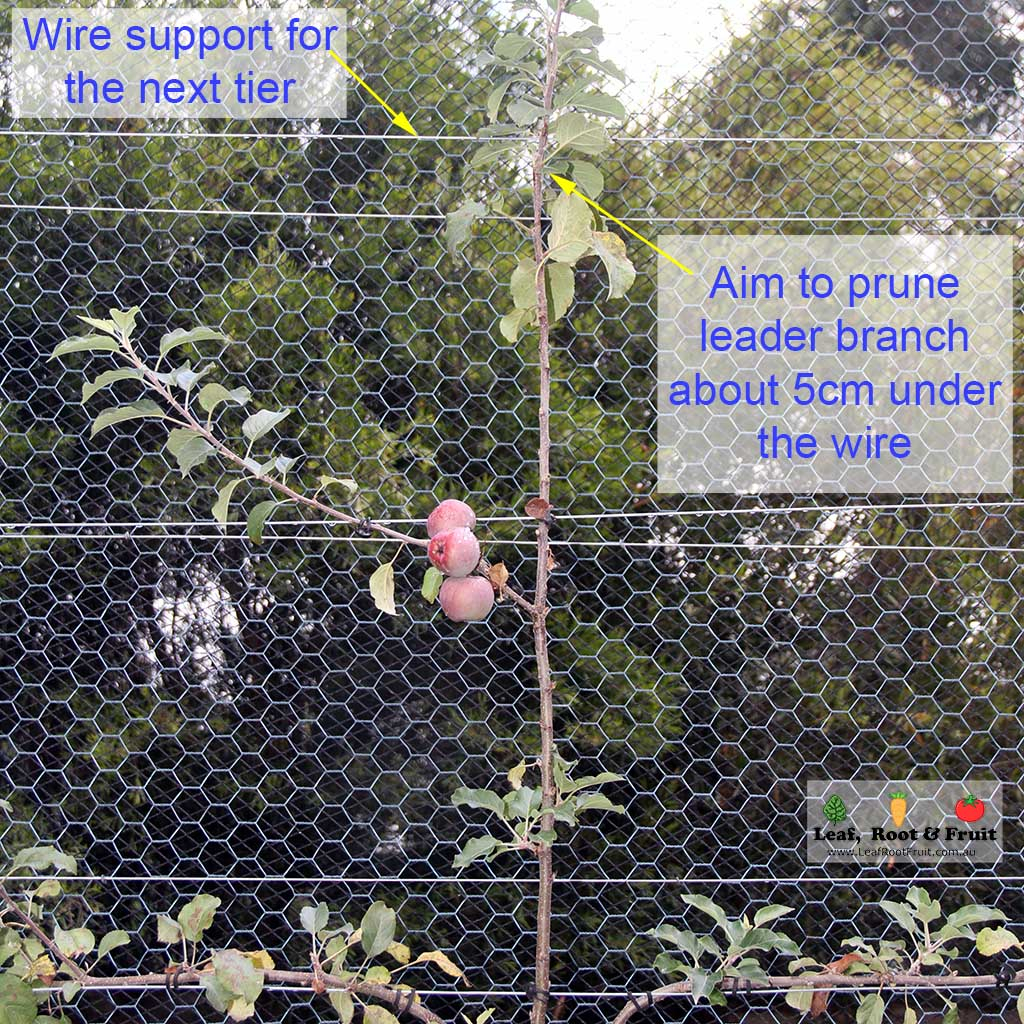
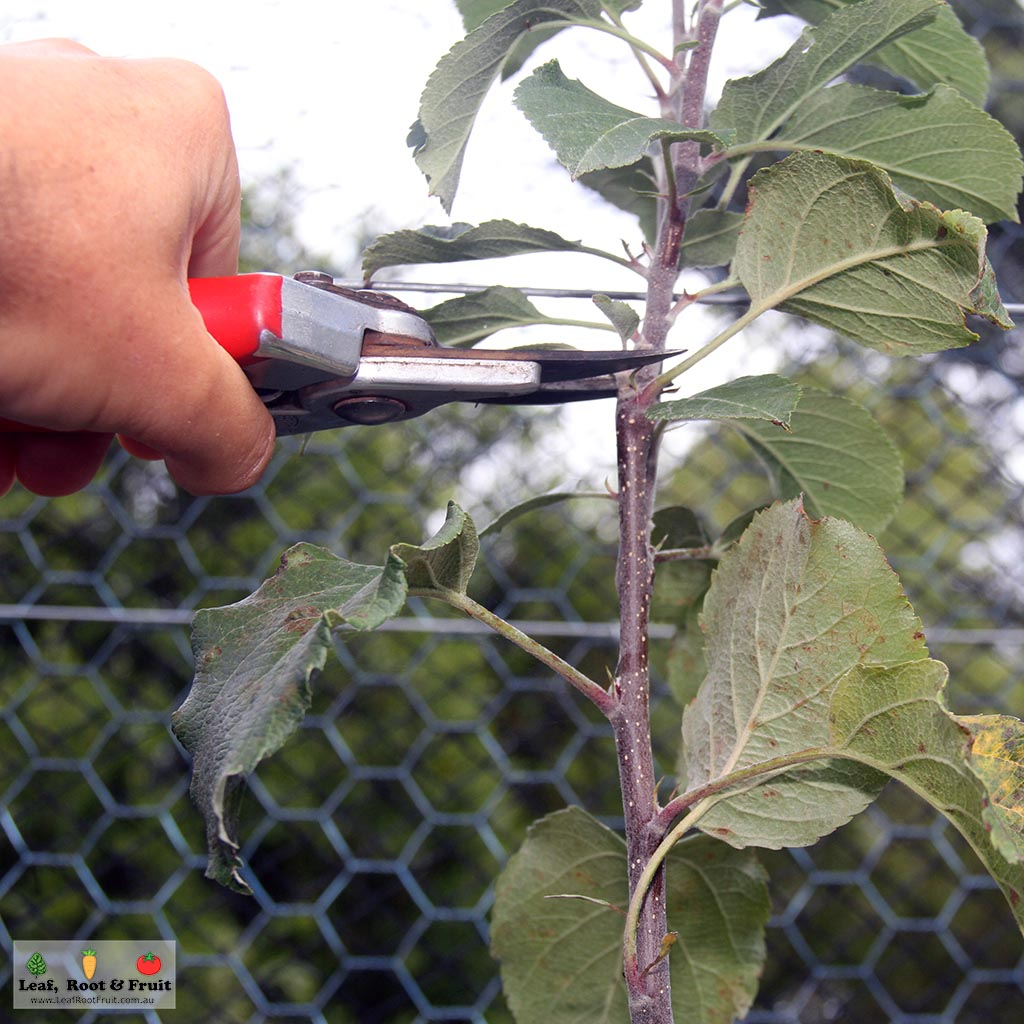
This will likely result in 3 to 5 new branches forming just below where the header cut was made. Two of these shoots can be bent down to form the lateral branches, one can be selected to continue growing the stem vertically. Any extra shoots can be removed.
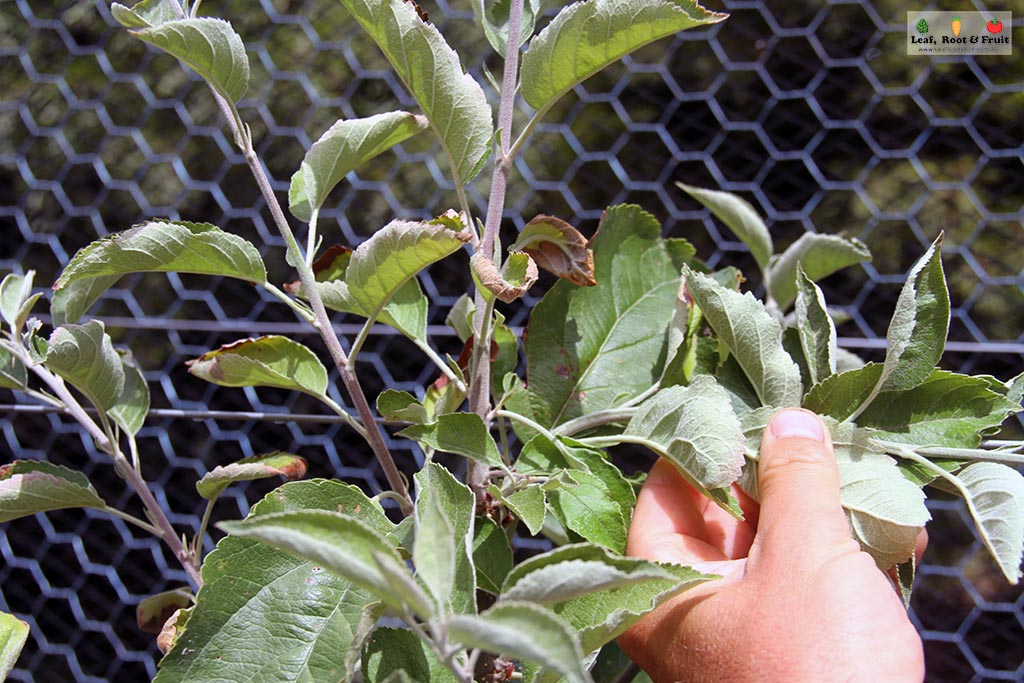
Multi-Grafted Espaliered Fruit Trees
It is possible to graft multiple varieties of fruit onto the one espalier fruit tree or to create fruit salad trees. Multi-graft trees can be a great use of space, can spread ripening out over a longer period of time and can help to overcome pollination issues.
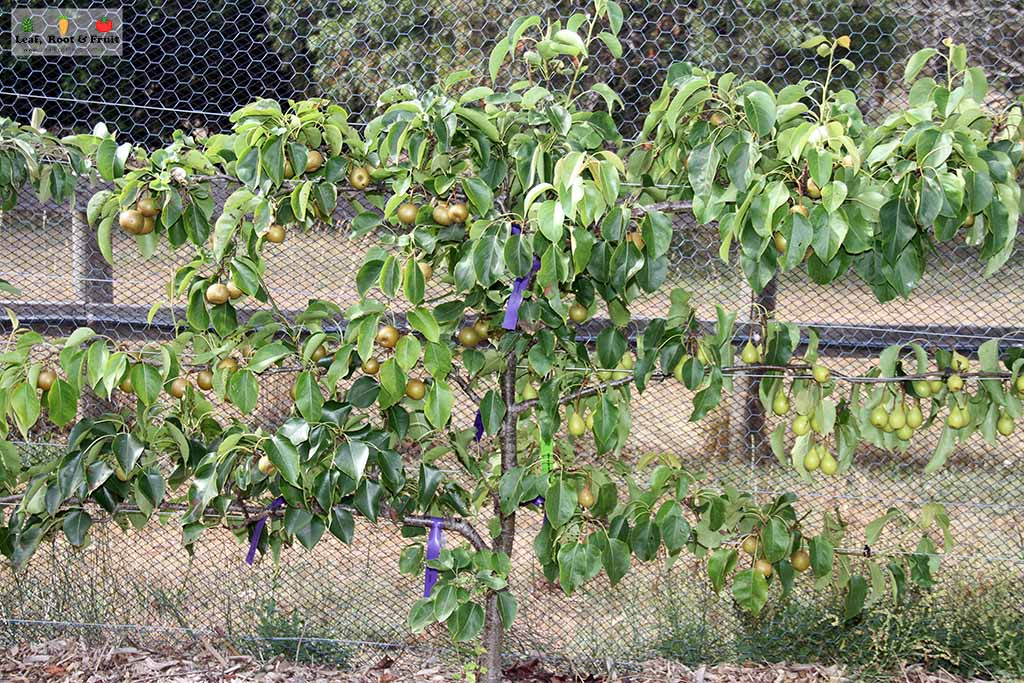
When grafting multiple varieties together, it is important to consider the vigour of each variety. Whilst most of the fruit tree vigour will be determined by the rootstock, some of the vigour is determined by the scion. When you have a tree that consists of multiple varieties of mis-matched vigour then you are likely to end up with an unbalanced tree.
A classic example of this is a multi-graft apple with Granny Smith and Pink Lady on the same tree. The Pink Lady is a much more vigorous variety and will soon come to dominate the tree. In a few years your tree will become a Pink Lady Tree with a tiny Granny Smith branch at the bottom. Variety vigour must be matched on Multi-graft trees, or much time must be spent on pruning back the vigorous variety to reduce dominance.
Apple vigour is designated as T1, T2 or T3, with the T3 being the most vigorous. Less information is available on the vigour of other fruit tree varieties.
I have been practicing the art of espaliering Multi-graft trees and am trying to perfect a standard tree layout for various types of fruit. These espalier trees have a different variety on each branch, and ripen from top to bottom. The focus is on creating a artistic yet productive tree for small space gardens. Check out some suggested Multi-Grafted, Espaliered Fruit Tree plans on my Substack page.
Want to Know More?
There’s a common joke in our industry:
“You can have five people standing around a fruit tree and eight different opinions on how to prune them!“
Nothing beats having someone stand in front of a tree and explain fruiting buds, tree shapes and the role of apical meristems to gain confidence in the art of fruit tree pruning. Rather than the “what” or the “how”, I focus on the “why” when supporting people to prune fruit trees.
If you are keen to join one of my fruit tree pruning classes, I normally host two workshops each year in my Demonstration Orchard in Kyneton:
- A fruit tree pruning masterclass focussing on Summer pruning held each February (when I believe we should be conducting much of our pruning activities)
- My Plant Physiology: Pruning and Plant Manipulation workshop held each June as part of the Science of Edible Gardening Workshop Series
See my upcoming events page for more details or sign up to my monthly newsletter to be kept informed of upcoming classes.
Alternatively you can book in for a Fruit Tree Pruning Masterclass in your own garden and I can focus mostly on espaliers.


I am contemplating multi grafting a gala apple should use the chip bud method to establish other varieties or whip and tongue on the main stem? What would be the best varieties to use.I am contemplating Granny Smith
Pink lady or Fuji as well as the Gala original tree.I am in Orange NSW and have horticultural experience.
Hi John,
I usually use whip and tongue grafts onto the base of lateral branches. You can graft any variety you like. It is critical that you match up the vigour of different varieties. Otherwise, you may end up with a lop-sided or top-heavy tree. I have put together some suggested plans for multigraft espaliers to make it easier for you: https://leafrootfruit.substack.com/p/grafting-plans-for-multi-graft-espaliered
Happy Grafting!
Duncan